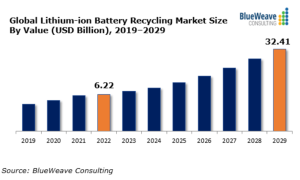2024 Look Ahead: Battery Safety and Compliance
Posted: January 9th, 2024
Authors: Michael L.As we look ahead to the lithium-ion battery industry in 2024, let’s first examine why we should be so interested in this segment of the United States (U.S.) economy. In 2022, the number of light-duty vehicles (cars) registered in the U.S. was 281 million. Of this number of registrations, electric (EVs) and plug-in hybrid (PHEV) vehicles represented only 1.2%1. By 2030, S&P Global Mobility estimates that over one in four (over 70 million) new passenger vehicles sold will be an EV2. This current and projected rapid growth of EVs on the road will cause the lithium-ion battery manufacturing and recycling industries to explode as well. The graphic below shows the expected growth of the lithium-ion battery recycling market size by the end of the decade.

As the market demand continues to increase for both electric vehicles and alternative energy storage (i.e., large lithium-ion batteries being used to store energy created by both solar and wind), the technology and regulations around the technology are developing and changing rapidly.
Advances around battery technology with impacts to storage, transportation, recycling, and disposal are on the rise. New rules and regulations will affect the industry from production to disposal and reuse. More specifically, as battery components change and larger batteries are being produced, look for updated rules and regulations from agencies such as the U.S. Department of Transportation (DOT), State Fire Marshall Offices, and the U.S. Environmental Protection Agency (EPA).
The U.S. EPA released a guidance memorandum back in May of 2023 that clarified the agency’s position that most lithium-ion batteries are likely hazardous waste under the Resource Conservation and Recovery Act (RCRA) regulations at end-of-life. Since then, the agency announced in November 2023 that it is planning to propose new rules to improve the management and recycling of end-of-life lithium-ion batteries. These rules will establish a new and distinct category of universal waste specifically tailored to lithium-ion batteries. U.S. EPA stated that there is concern about the possibility for fires when batteries are improperly managed and that represents a risk that needs to be addressed by modified universal waste regulations. This is in response to a 2021 U.S. EPA Report3 on fires caused by lithium-ion batteries in the waste management process and feedback from a corresponding workshop. As with any new rules, this one will take time to develop but ALL4 will be watching to see how this one evolves in 2024. The agency also set up a website which can be used to track this space.
Additionally, just when we thought air emissions and use of batteries didn’t go together, we found out there are facilities performing thermal runaway evaluations (burn tests) on batteries to obtain certification for their safe use in certain applications. ALL4 has evaluated air emissions data and whether there are air permitting requirements for these operations and will continue to take on cutting edge projects like this in 2024 to stay at the forefront of this emerging industry.
ALL4 held a webinar back in September of 2023 that was comprised of special guests from both industry and government agencies (we were honored to have representatives from both U.S. EPA and DOT participate and answer questions) talking all about lithium-ion environmental regulations and safety. This webinar gave wonderful insight on where regulations are headed from the agencies’ perspectives in much more detail that we can provide in the limited space here. If you are interested in learning more, I suggest you check out that webinar and also make a note that we are planning another follow up webinar in early 2024 to continue the discussion.
Additionally, continue to look for developments with existing and fully viable technologies such as lead-acid batteries. Storage capacities and design continue to drive the components of batteries in the marketplace. Lead-acid batteries are still more viable for certain applications where more storage is required and weight is not the issue. We are up-to-date on the potentially changing environmental requirements for these facilities. For stakeholders doing business in California, we are intently following the proposed Cal/OSHA regulation that is lowering the permissible exposure limit (PEL) from 50 µg/m3 to 10 µg/m3. There will be a lot of activity on this proposed rule in 2024 and ALL4 will be on top of it every step of the way.
Finally, if you are reading this and want to learn more about how ALL4 can assist you and your facility with lithium-ion battery safety and compliance, please note that we have developed the “ALL4 Path to Lithium-Ion Battery Safety & Compliance”. The pathway to a safe and compliant facility includes the following steps:
- Introductory meeting to discuss strategy with Facility Stakeholders;
- Onsite compliance gap analysis;
- Preparation of Standard Operating Procedures or a compliance Battery Management Program; and
- Conduct onsite or virtual training for employees.
Learn more about the “ALL4 Path to Lithium-Ion Battery Safety & Compliance” and review our battery compliance resources here: https://www.all4inc.com/battery-recycling-services/
If you have questions or need assistance with permitting, storage requirements, hazardous material planning, or evaluation of your current practices, please contact Mike Liebert at MLiebert@all4inc.com. Our ESG team can also assist your company with determining and documenting provenance of recycled materials; contact Daryl Whitt at dwhitt@all4inc.com.
1https://afdc.energy.gov/vehicle-registration
2https://www.spglobal.com/mobility/en/topic/electric-vehicle-trends.html

